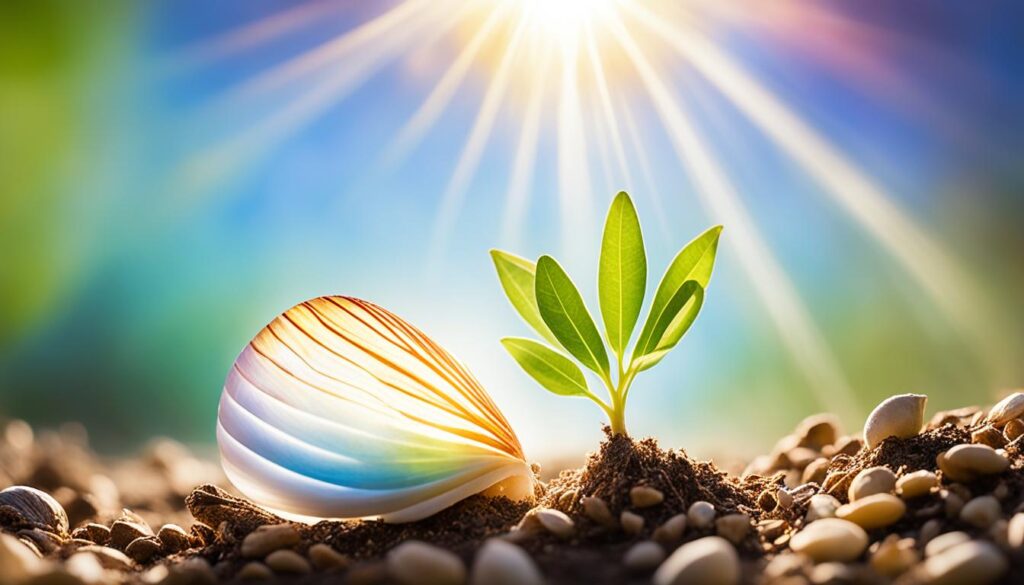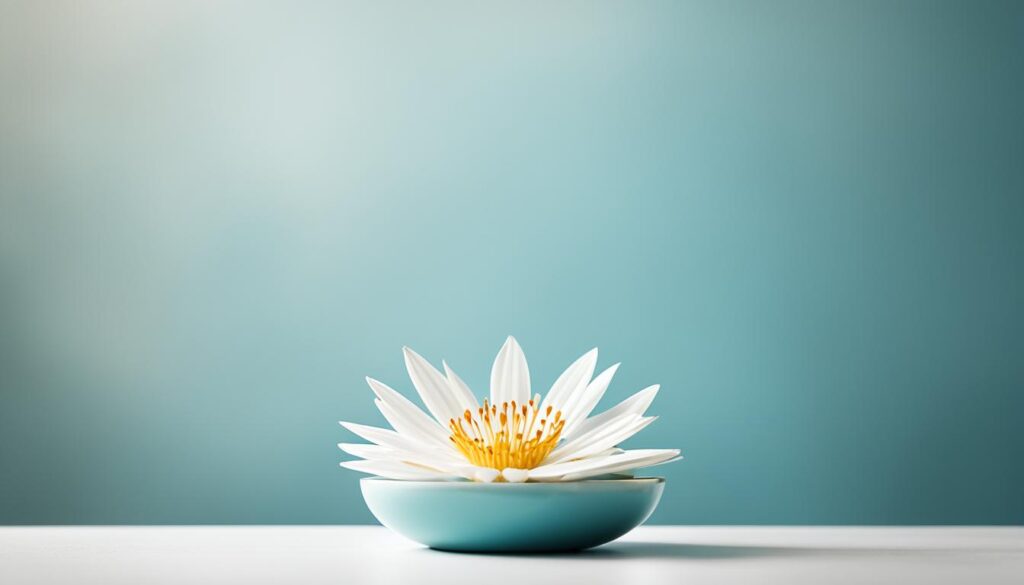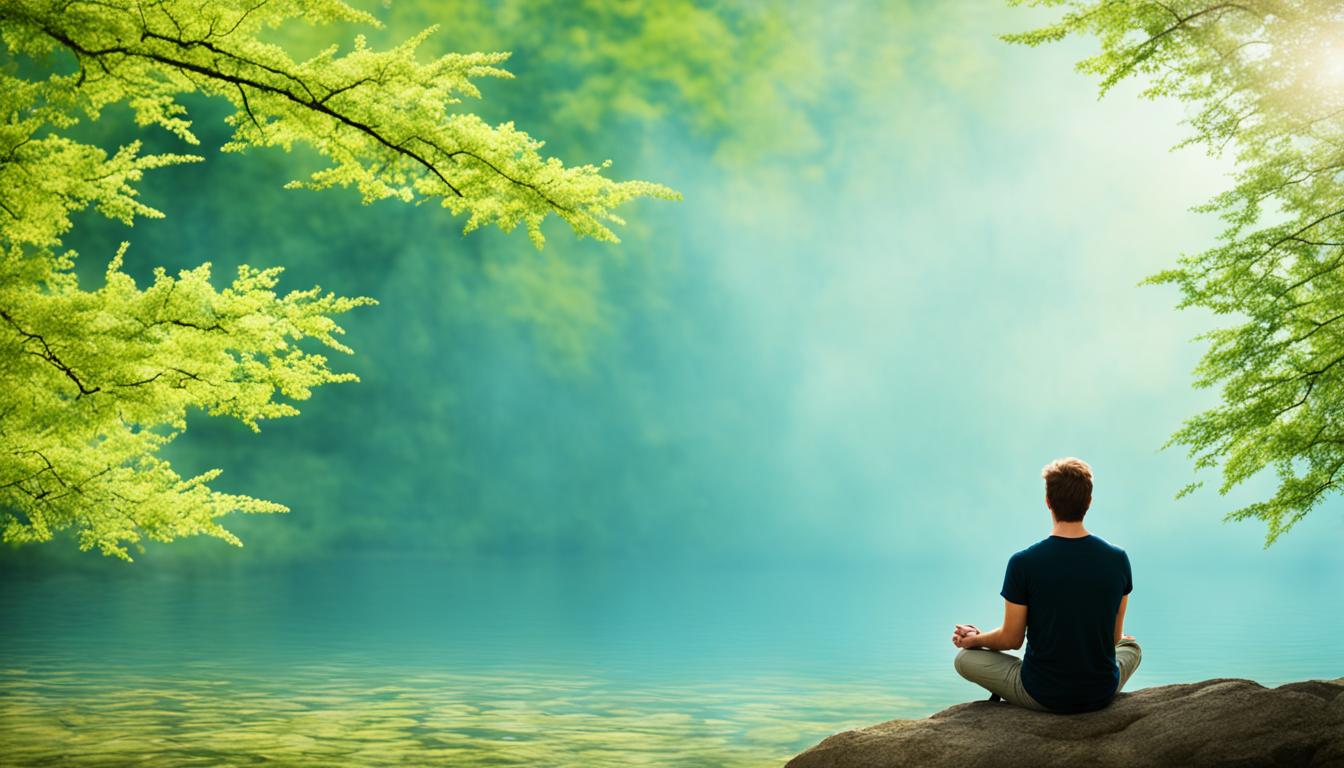Did you know that the average person has over 6,000 thoughts a day? With so many thoughts, worries, and distractions constantly buzzing in our minds, it’s no wonder that finding clarity in life can feel like a huge challenge. But what if there was a way to quiet the chaos and cultivate a peaceful mind?
Introducing stillness – the practice of embracing mindful living to achieve mental clarity and peace. By intentionally creating moments of quiet and disconnecting from external distractions, we can tap into our inner wisdom and find clarity in life. Stillness is not just about escaping the noise; it’s about fully embracing the present moment and experiencing life with greater awareness.
In this article, we will explore the power of stillness and how it can help overcome overthinking, curb mental restlessness, and unlock our true potential. We’ll delve into the importance of cultivating awareness, practicing self-reflection, and cultivating qualities like gratitude and compassion. We’ll also learn practical tips for incorporating stillness into our daily lives, overcoming distractions, and developing focus.
Key Takeaways:
- Stillness is the practice of embracing mindful living to find clarity in life.
- By disconnecting from external distractions, we can tap into our inner wisdom and experience mental peace.
- Practicing stillness involves cultivating awareness, practicing self-reflection, and embracing qualities like gratitude and compassion.
- Stillness can be incorporated into our daily lives through activities like meditation, journaling, and exercise.
- Overcoming distractions and developing focus are essential in maintaining a stillness practice.
The Power of Stillness in Overcoming Overthinking
Overthinking can trap us in a cycle of mental noise and restlessness. The constant chatter in our minds can make it difficult to find peace and clarity. However, there is a powerful tool that can help us overcome overthinking and find a peaceful mind – stillness.
Stillness is more than just the absence of activity; it is a state of being fully present in the moment. By practicing mindfulness and being aware of our thoughts and emotions without judgment, we can create a space of stillness within ourselves. In this space, we can observe our thoughts without getting entangled in them, allowing them to pass by like clouds in the sky.
When we practice stillness, we give ourselves the opportunity to quiet the noise in our minds and find mental freedom. The distractions and worries that often consume our thoughts begin to lose their power as we focus on the present moment. We become more attuned to our inner selves and develop a deeper understanding of our thoughts and emotions.
Through stillness, we can cultivate a peaceful mind that is less prone to overthinking. We learn to let go of the need to control every thought and outcome, and instead, embrace the beauty of simply being. In this state of stillness, we find clarity and a sense of calm that allows us to navigate life with greater ease and joy.
“Stillness is not the absence or negation of energy, life, or movement. It is the nourishing ground for the realization of peace, clarity, and wisdom.” – Eckhart Tolle
The Benefits of Stillness in Overcoming Overthinking
The practice of stillness offers a range of benefits that can help us overcome overthinking and cultivate a peaceful mind:
- Clarity of thought: Stillness helps us clear the mental clutter and gain a clearer perspective on our thoughts and emotions.
- Reduced stress and anxiety: By finding stillness, we can reduce stress and anxiety levels, allowing for a greater sense of peace and well-being.
- Improved focus and concentration: Through stillness, we can train our minds to stay focused on the present moment, improving our ability to concentrate on tasks.
- Enhanced creativity: Stillness provides space for our creative ideas to flow and flourish, allowing us to tap into our creative potential.
- Increased self-awareness: By practicing stillness, we become more aware of our thoughts, emotions, and patterns of behavior, leading to greater self-understanding and self-compassion.
Incorporating stillness into our daily lives can have a profound impact on our overall well-being. It helps us overcome overthinking and fosters a sense of inner peace and clarity. By embracing the power of stillness, we can create space for growth, self-discovery, and a more peaceful mind.
Cultivating Awareness to Overcome Mental Restlessness
When it comes to finding clarity and peace of mind, awareness is a vital element in our journey. However, it goes beyond simply noticing our thoughts. It involves delving deeper and understanding the patterns of our mind. By cultivating awareness, we can start to unravel the complexities of our overactive thoughts and overcome mental restlessness.
Being aware of our habitual thought processes allows us to see the futility of overthinking. We begin to realize that continuously pondering over the same thoughts only burdens our mind further. Cultivating awareness enables us to let go of unnecessary mental burdens and embrace a more tranquil state of being.
“Awareness is like a gentle breeze that clears the fog of confusion, revealing the path towards clarity and peace of mind.”
Through the practice of awareness, we become observers of our thoughts. We develop the ability to detach ourselves from our swirling mental chatter and adopt a more impartial stance. This non-judgmental perspective allows us to release the hold that overthinking has on our thoughts and emotions.
Cultivating awareness is a gradual process that requires patience and practice. It calls for active engagement with our thoughts, emotions, and the present moment. As we deepen our understanding of our mental patterns, we gain the freedom to choose how we respond to our thoughts, rather than being controlled by them.
Benefits of Cultivating Awareness:
- Reduced mental restlessness
- Increase in clarity of thought
- Enhanced emotional well-being
- Improved decision-making abilities
- Greater self-awareness
By taking the time to cultivate awareness, we open the door to clarity and peace within ourselves. It is a transformative practice that empowers us to break free from the chains of mental restlessness and embrace a more serene state of being.
| Steps to Cultivate Awareness | Benefits |
|---|---|
| 1. Mindfulness meditation | Fosters present-moment awareness and reduces overthinking |
| 2. Journaling | Enhances self-reflection and understanding of thought patterns |
| 3. Breathwork exercises | Brings focus to the present moment and calms the mind |
| 4. Body scan meditation | Develops a deeper connection between the mind and body |
| 5. Engaging in mindful activities | Promotes a state of flow and heightened awareness |

By cultivating awareness, we can transcend the constant flurry of thoughts and find solace in the serenity of the present moment. It is through this practice that we can overcome mental restlessness and discover a profound sense of clarity and peace within ourselves.
The Importance of Stillness for Mental Clarity and Peace
In today’s fast-paced world, finding moments of stillness is essential for our mental well-being. It is during these serene pauses that we can disconnect from the external chaos and connect with our inner selves. By intentionally practicing stillness, whether through meditation, quiet walks, or moments of silence, we can achieve mental clarity and peace of mind.
Stillness allows us to quiet the constant chatter of our minds and center our thoughts. It provides us with the space to observe our thoughts without judgment, gaining a deeper understanding of ourselves and our experiences. This self-awareness leads to mental clarity, enabling us to make more conscious decisions and navigate life with greater ease.
When we embrace stillness, we create a sanctuary within ourselves, where our thoughts can settle, and our minds can rest. This state of calmness promotes a sense of tranquility and peace, allowing us to release stress and find solace in the present moment.
“In stillness, we find our true selves. It is within the silence that we hear the whispers of our soul, guiding us towards our most authentic path.”
The Benefits of Stillness
By prioritizing stillness in our daily lives, we can reap numerous benefits that enhance our overall well-being:
- Mental Clarity: Stillness helps clear the mental fog, allowing us to think more clearly, make better decisions, and solve problems efficiently.
- Reduced Stress: Taking moments of stillness helps reduce stress levels, promoting a sense of calm and improving our ability to manage everyday challenges.
- Enhanced Focus: By quieting the mind, stillness enhances our ability to concentrate, improving our productivity and performance in various tasks.
- Improved Emotional Balance: Stillness provides us with the space to connect with our emotions, fostering self-awareness and promoting emotional stability.
- Increased Resilience: Regular practice of stillness cultivates resilience, empowering us to face life’s uncertainties with a calm and composed mindset.

Comparing Different Stillness Practices
| Practice | Focus | Benefits |
|---|---|---|
| Meditation | Internal awareness | Improved focus, stress reduction, emotional balance |
| Quiet walks in nature | Connection with the environment | Enhanced mindfulness, reduced anxiety, increased creativity |
| Moments of silence | Internal reflection | Clarity of thought, emotional rejuvenation, improved decision-making |
By incorporating stillness into our daily routines, we create a foundation of peace and mental clarity that supports us in all aspects of life. It is through these moments of stillness that we find refuge and nourish our souls, allowing us to navigate the world with a renewed sense of purpose and tranquility.
Self-Reflection as a Key Aspect of Stillness
When we think of stillness, our initial focus may be on disconnecting from the external world. However, stillness goes beyond finding physical tranquility; it also involves a deep sense of self-awareness and reflection. Self-reflection plays a crucial role in our journey towards clarity and peace.
We must be willing to see ourselves as we truly are, without judgment or criticism.
Self-reflection is the practice of consciously exploring our thoughts, emotions, and actions without attaching labels or evaluating them. It allows us to observe our inner experiences with a compassionate attitude, embracing them as a part of our human nature.
By engaging in self-reflection, we develop a greater understanding of our emotional states and patterns. We gain insights into the root causes of our anxieties, fears, and worries. This process enables us to cultivate a compassionate attitude towards ourselves, recognizing that we are deserving of understanding, forgiveness, and self-acceptance.
Self-reflection brings light to the shadows within us and illuminates our path towards inner peace and growth.
Through stillness and self-reflection, we create a safe space where we can confront the inner turmoil and dissonance that may hinder our clarity. We learn to listen to our inner voice with kindness and curiosity, allowing valuable insights to emerge.
This practice of self-reflection also deepens our connection with others. As we develop compassion for ourselves, we naturally extend that same compassion towards others. We start to see the shared humanity beneath our surface differences, fostering empathy and understanding in our relationships.
Self-reflection offers us the opportunity to pause, reassess, and make conscious choices aligned with our values and aspirations. It allows us to align our actions with our authentic selves and create a life that is true to who we are.
| Benefits of Self-Reflection | How to Practice Self-Reflection |
|---|---|
|
|
Self-reflection is an ongoing practice that requires patience, openness, and a genuine desire to understand ourselves. As we continue to cultivate this skill, we unlock the power of stillness and embark on a transformative journey towards clarity, peace, and self-discovery.

The Power of Gratitude and Compassion in Stillness
In stillness, we have the opportunity to cultivate two powerful qualities that not only bring us peace of mind but also have the potential to transform the world around us. Gratitude and compassion, when practiced in stillness, enhance our well-being and create a ripple effect of positivity and kindness.
Gratitude is a shift in perspective, a conscious choice to focus on the blessings in our lives rather than dwelling on what is lacking. It allows us to appreciate the present moment and find joy in the simple things. When we practice gratitude in stillness, we train our minds to notice the small miracles and find contentment in the present.
“Gratitude turns what we have into enough.”
On the other hand, compassion is the heart’s response to the suffering and struggles of others. It is a deep empathy that moves us towards acts of kindness and understanding. When we practice compassion in stillness, we cultivate a sense of connection with all beings and foster a world infused with love and acceptance.
“Compassion is not a relationship between the healer and the wounded. It’s a relationship between equals. Only when we know our own darkness well can we be present with the darkness of others.” – Pema Chödrön
Together, gratitude and compassion create a harmonious synergy in our stillness practice. Gratitude brings us into alignment with the abundance of the present moment, while compassion expands our hearts and deepens our connection to the world. These qualities enrich our experience of stillness and open us up to a greater understanding of ourselves and others.

By nurturing a practice of gratitude and compassion in stillness, we become vessels of love and kindness. We bring these qualities into our interactions with others, infusing our relationships with empathy and understanding. Through stillness, we can create a ripple effect of gratitude and compassion that has the power to transform not only our own lives but the lives of those around us.
Embracing the Present Moment and Awakening to Potential
Embracing the present moment is a transformative practice that allows us to tap into the extraordinary potential that exists within our awareness. It goes beyond simply quieting the mind; it is about fully immersing ourselves in the richness of the ‘now’. By anchoring ourselves in the present, we can awaken to the depths of our inner clarity, making more conscious decisions and living a more intentional life.
The practice of stillness is a powerful tool on this journey of self-discovery. It provides us with a sanctuary of calm amidst the chaos of everyday life. Through stillness, we create a sacred space where we can connect with our deepest selves and access the wisdom that resides within us.
“In today’s fast-paced world, it’s easy to get caught up in the flurry of distractions and commitments. The practice of stillness helps us ground ourselves, allowing us to fully embrace the present moment and unlock our true potential.”
When we embrace the present moment, we become more attuned to our surroundings and the experiences that unfold before us. We start to notice the subtleties of life that often go unnoticed—the gentle sway of trees, the warmth of the sun on our skin, or the laughter of loved ones. By fully immersing ourselves in the present, we deepen our connection to the world around us and find profound joy in even the simplest of moments.
Awakening to our potential requires us to let go of past regrets and future anxieties, and instead focus on what is within our control—the present. It is in this moment that we have the power to shape our lives and make choices that align with our true values and aspirations.
Stillness practice guides us on this path of self-discovery by helping us cultivate a sense of inner spaciousness. It teaches us to observe our thoughts and emotions without judgment, allowing us to gain clarity and insight into our inner landscape.

The image above perfectly captures the essence of embracing the present moment and awakening to our potential. The serene lake reflects the calmness and clarity we can experience when we immerse ourselves fully in the present. It serves as a visual reminder of the transformative power that lies within stillness practice.
Through the practice of stillness, we open ourselves up to new possibilities and perspectives. We become more attuned to our intuition and inner guidance, allowing us to make decisions that align with our authentic selves. With each moment of stillness, we awaken to our true potential and step into a life filled with purpose and meaning.
Let us embrace the present moment, awaken our potential, and embark on a journey of self-discovery through the transformative practice of stillness.
The Power of Embracing the Present Moment:
- Experience a deeper connection to the world around us
- Find joy and beauty in even the simplest of moments
- Let go of past regrets and future anxieties
- Shape our lives through conscious choices
Awakening to Potential Through Stillness:
- Cultivate a sense of inner spaciousness
- Observe thoughts and emotions without judgment
- Gain clarity and insight into our inner landscape
- Open ourselves up to new possibilities and perspectives
The journey of embracing the present moment and awakening to our potential begins with stillness practice. It is through the intentional cultivation of present-moment awareness that we unlock the extraordinary potential that lies within each of us.
Small Steps Towards Stillness and Inner Voice Tuning
Reaching a state of stillness may seem overwhelming, but it starts with taking small steps and intentionally disconnecting from the noise and distractions around us. By incorporating simple practices into our daily routine, we can gradually cultivate a sense of tranquility and inner peace.
One powerful way to begin the journey towards stillness is through mindfulness. Mindfulness involves being fully present in the moment and observing our thoughts and emotions without judgment. It allows us to tune into our inner experiences and develop a greater awareness of our thoughts, feelings, and bodily sensations.
“Mindfulness is the key to unlock the door to stillness within.”
Another effective practice is meditation. Taking just a few minutes each day to sit in silence and focus on our breath can have profound effects on our mental well-being. It helps calm the mind, reduce stress, and cultivate a sense of inner clarity. With consistent practice, we can strengthen our ability to enter a state of stillness and tap into our inner wisdom.
Connecting with nature is another valuable pathway to stillness. Taking a peaceful walk in the woods, feeling the warmth of the sun on our skin, or listening to the sound of waves crashing on the shore can all bring us closer to a state of tranquility. Nature has a unique way of grounding us in the present moment and helping us find peace within.
As we journey towards stillness, it is important to tune into our inner voice and embrace self-reflection. Our inner voice is our intuition, guiding us towards what feels right and true for us. By taking moments throughout the day to listen to our inner voice, we can gain insights, make wiser decisions, and align with our authentic selves.
In the words of Rumi:
“Listen to silence. It has so much to say.”
By engaging in regular self-reflection, journaling, or contemplative practices, we can deepen our connection with our inner voice and tap into the profound wisdom that resides within us.
Remember, stillness is not achieved overnight. It is a lifelong practice that requires patience, dedication, and a compassionate attitude towards ourselves. But every small step we take towards stillness brings us closer to a more peaceful and fulfilling life.
The Benefits of Stillness in Mental Clarity and Focus
Stillness is a powerful tool for developing mental clarity and focus. By creating moments of stillness and disconnecting from distractions, we can train our minds to stay calm and focused. Activities like meditation, yoga, or walking help ground our thoughts and enhance our ability to be present. Ultimately, stillness strengthens our mental clarity and focus.
The Power of Stillness
In our fast-paced world, finding moments of stillness can be challenging. However, incorporating stillness practices into our daily lives can have numerous benefits for our overall well-being. When we allow ourselves to be still, we create space for our minds to quiet down and for mental clarity to emerge.
“In the midst of movement and chaos, keep stillness inside of you.” – Deepak Chopra
Training the Mind to Stay Calm
Practicing stillness allows us to cultivate an inner calmness that extends beyond moments of stillness. As we train our minds to stay calm in stillness, we develop the ability to remain focused even in challenging and chaotic situations. This mental resilience enables us to approach tasks with clarity and make more deliberate decisions.
Enhancing Mental Clarity and Focus
By disconnecting from external distractions and turning inward, stillness helps us sharpen our mental focus. When we are still, we can direct our attention to a specific task or thought, reducing mental clutter and increasing our ability to concentrate. This enhanced mental clarity allows us to prioritize effectively and accomplish tasks with greater efficiency.
Strengthening Mind-Body Connection
Stillness practices, such as yoga and meditation, promote a stronger mind-body connection. By slowing down and being present in our bodies, we become more attuned to our physical sensations, emotions, and thoughts. This heightened awareness enhances our ability to focus on the present moment and respond to our surroundings with clarity and intention.
Creating Space for Creative Thinking
When our minds are cluttered with distractions, it can be challenging to tap into our creativity. Stillness provides a space for our minds to settle, giving way to innovative and imaginative thinking. By allowing ourselves moments of stillness, we open ourselves up to new ideas, possibilities, and solutions to challenges we may face.
| Benefits of Stillness | Mental Clarity | Focus |
|---|---|---|
| Enhances concentration |  |
 |
| Elevates problem-solving skills |  |
 |
| Reduces stress and anxiety |  |
 |
| Enhances decision-making abilities |  |
 |
Spending intentional time in stillness allows us to tap into the benefits of mental clarity and focus. By making stillness a regular practice, we can enhance our ability to concentrate, think creatively, and make decisions with clarity. Whether through meditation, yoga, or other forms of quiet reflection, embracing stillness can have transformative effects on our mental well-being.
Building Confidence Through Stillness
Stillness practice has the power to build our self-confidence and empower us in various aspects of life. By creating moments of stillness, we tap into a state where nothing else matters, allowing us to become more confident and assertive. In this state of stillness, our posture, voice tone, and body language naturally shift, reflecting our newfound confidence and inner strength.
When we practice stillness, we cultivate a sense of inner calm, which directly impacts our external presence. Our stillness radiates poise and composure, making us appear more self-assured and approachable in our interactions. Others pick up on this energy and perceive us as confident individuals.
Embracing stillness allows us to develop a deep sense of self-awareness. As we observe our thoughts, emotions, and reactions with equanimity, we gain insight into our fears and insecurities. This understanding enables us to confront our limitations and overcome them, fostering a greater sense of self-confidence.
Additionally, practicing stillness enhances our ability to listen and communicate effectively. When we are fully present in the moment, we can actively engage in conversations with clarity and attentiveness. This active engagement not only strengthens our relationships but also boosts our confidence in expressing our thoughts and ideas.
“Building confidence through stillness is not about being perfect or fearless. It’s about embracing our imperfections and fears with compassion, and recognizing our inherent worth and potential.”
Furthermore, stillness practice helps us develop resilience and perseverance. By staying present and focused during challenging situations, we become less prone to self-doubt and more resilient in the face of adversity. This resiliency fuels our confidence and enables us to navigate life’s obstacles with courage and determination.
Incorporating stillness into our daily lives allows us to cultivate a more assertive personality. Through regular practice, we develop an unshakeable sense of self, rooted in our inner stillness. This assertiveness permeates all aspects of our lives, empowering us to make decisions with confidence and take bold actions towards our goals.
Ultimately, building confidence through stillness is a transformative journey of self-discovery and self-acceptance. As we tap into our inner reservoir of calm and clarity, we unlock our true potential and embrace life with certainty and conviction.

| Benefits of Building Confidence Through Stillness | How Stillness Enhances Confidence |
|---|---|
| 1. Increased self-assurance | 1. Shifts in posture, voice tone, and body language |
| 2. Improved presence and approachability | 2. Radiating calm and composure |
| 3. Deeper self-awareness | 3. Confronting fears and insecurities |
| 4. Enhanced communication skills | 4. Active listening and effective expression |
| 5. Resilience and perseverance | 5. Staying focused in challenging situations |
| 6. Cultivating assertiveness | 6. Confidence in decision-making and taking action |
Developing Patience Through Stillness
Stillness practice is not only about finding peace and clarity but also strengthening our patience. By intentionally creating moments of stillness and sitting quietly, we cultivate the art of patience. Patience allows us to remain calm and composed, even under pressure, and opens the door to long-term focus for our goals and aspirations.
In today’s fast-paced world, patience is a valuable quality that can make a significant difference in our lives. When we approach challenges with patience, we are better equipped to handle setbacks, navigate difficult situations, and maintain our composure. Patience helps us resist impulsive actions or decisions that may hinder our progress, allowing us to think in the long term and build a solid foundation for success.
When we practice stillness, we learn to observe our thoughts and emotions without judgment or immediate reaction. This practice trains us to cultivate patience not only with ourselves but also with others, enhancing our relationships and promoting understanding. Through patience, we develop empathy and compassion, which in turn strengthen our connection with those around us.
The key to developing patience through stillness is to embrace the present moment and accept it as it is. By grounding ourselves in the here and now, we gradually release the need for instant gratification and cultivate an attitude of patience and perseverance.
Stillness practice offers a sanctuary from the constant noise and distractions of everyday life, allowing us to find peace within ourselves and develop patience for the journey we are on. It teaches us to be present, to trust the process, and to have faith in our own abilities. With patience, we can move through life with a calm and resilient mindset, ready to face any challenges that come our way.
| Benefits of Developing Patience Through Stillness: |
|---|
| 1. Increased resilience |
| 2. Enhanced problem-solving skills |
| 3. Improved decision-making abilities |
| 4. Deeper sense of calm and peace |
| 5. Strengthened relationships through empathy and understanding |
Patience in Action: A Mindful Approach
When faced with moments of impatience or frustration, we can apply mindful techniques to cultivate patience:
- Take a breath: Pause and take a deep breath, allowing yourself a moment of stillness. This simple act can create space for patience to arise.
- Practice gratitude: Shift your focus to gratitude, acknowledging the present moment and finding appreciation for what is already here. This shift in perspective can help cultivate patience.
- Observe your emotions: Notice any impatience or frustration that arises within you. Allow these emotions to be present without judgment, practicing self-compassion and understanding.
- Embrace imperfection: Recognize that not everything goes according to plan. Embracing the imperfections of life allows us to let go of expectations and develop patience for the unfolding of events.
The journey to developing patience is not always easy, but with consistent stillness practice, we can strengthen this valuable quality and enjoy the benefits it brings to our lives. Let us embrace stillness, cultivate patience, and embrace the beauty of the present moment.
How to Practice Stillness Daily
Practicing stillness daily doesn’t have to be complicated. It is a simple yet powerful practice that can bring peace and clarity to our lives. By incorporating stillness into our daily routine, we can cultivate mindfulness, reduce stress, and enhance our overall well-being.
Here are some practical ways to practice stillness on a daily basis:
1. Morning Moments of Stillness
Start your day with a sense of calm: Take just 7 minutes each morning to sit quietly, find a comfortable position, and focus on your breath. Observe the sensations in your body and allow yourself to be present in the moment. This practice can help you start your day with a clear and centered mind.
2. Create a Quiet Environment
Find a peaceful space: Choose a quiet and clutter-free area where you can practice stillness without distractions. Create an environment that promotes relaxation, such as dimming the lights, playing soft instrumental music, or lighting a scented candle. Making your space conducive to stillness can enhance your practice.
3. Set a Timer
Allocate dedicated time: Set a timer for your stillness practice to ensure that you allocate a specific amount of time each day. Start with a duration that feels comfortable for you, whether it’s 5 minutes or 20 minutes. Gradually increase the time as you become more accustomed to the practice.
4. Consistency is Key
Make it a habit: Incorporate stillness into your daily routine and commit to practicing it consistently. Whether you choose to practice in the morning, during your lunch break, or before bedtime, find a time that works best for you and stick to it. Consistency will help you cultivate the benefits of stillness over time.
5. Explore Mindfulness Exercises
Engage in activities that promote presence: Stillness can be practiced not only through seated meditation but also through various mindfulness exercises. Engage in activities that bring you into the present moment, such as mindful walking, yoga, or journaling. Find what resonates with you and incorporate it into your stillness practice.
“The present moment is the only time over which we have dominion.” – Thich Nhat Hanh
Practicing stillness daily can bring a sense of clarity and calmness to our lives. It allows us to connect with our inner selves and cultivate a deeper understanding of our emotions and thoughts. By making stillness a daily practice, we can experience the transformative power of being fully present in each moment.
Overcoming Distractions and Developing Focus
Distractions are the enemy of stillness. In order to fully engage in the practice of stillness, we must learn to overcome these distractions and create a focused environment. By doing so, we can enhance our ability to develop focus, cultivate a peaceful mindset, and experience profound moments of clarity.
One effective strategy to overcome distractions during stillness practice is to put your phone on airplane mode or turn it off completely. This eliminates the temptation to check notifications or respond to messages, allowing you to fully immerse yourself in the present moment.
Finding a quiet place is another crucial step in minimizing distractions. Seek out a peaceful environment where you can disconnect from external noises and disruptions. It could be a secluded corner in your home, a serene outdoor spot, or a dedicated meditation space.
Using mindfulness techniques can also help maintain focus during stillness practice. By directing your attention to your breath, bodily sensations, or a specific mantra, you can anchor your mind and redirect it from wandering thoughts. Mindfulness allows you to stay centered and fully engage in the present moment.
Consistency is key in developing focus and resisting distractions. Make stillness practice a regular part of your daily routine, even if it’s just for a few minutes. Over time, you’ll notice the cumulative effect of this consistent effort, as your ability to concentrate and maintain focus improves.
Benefits of Overcoming Distractions and Developing Focus
Overcoming distractions and developing focus through stillness practice offer numerous benefits:
| Benefits | Explanation |
|---|---|
| Increased productivity | Focus allows you to complete tasks efficiently and with greater accuracy. |
| Enhanced creativity | By minimizing distractions, you create space for innovative ideas and inspiration to flow. |
| Improved decision-making | Clarity of mind helps you make thoughtful decisions based on your values and priorities. |
| Reduced stress | Developing focus allows you to let go of unnecessary worries and experience inner calm. |
| Deepened self-awareness | As distractions fade away, you become more attuned to your own thoughts, emotions, and desires. |
Questions and Answers About Stillness Practice
As we embark on our journey of stillness practice, it’s natural to have questions and concerns. Here, we address some common FAQs to help deepen our understanding and guide us along the path towards clarity and peace.
1. Where is the best place to practice stillness?
Finding a quiet and peaceful place is essential for a successful stillness practice. It could be a dedicated meditation room, a serene spot in nature, or simply a comfortable corner in your home. Experiment with different settings to find what works best for you.
2. How do I deal with distractions during my stillness practice?
Distractions are inevitable, but we can learn to navigate through them. Start by acknowledging any external distractions and gently redirect your focus back to the present moment. You can also practice mindfulness techniques, such as observing the distractions without judgment, to cultivate a calm and focused mind.
3. How often should I practice stillness?
The frequency of stillness practice varies for each person. It’s beneficial to set aside dedicated time every day, even if it’s just a few minutes, to cultivate a consistent practice. As you progress, you may find it helpful to gradually increase the duration of your practice.
4. What are the benefits of incorporating stillness into my daily life?
Stillness practice offers a multitude of benefits for our mental, emotional, and physical well-being. Regular practice can lead to increased mental clarity, reduced stress, improved focus, enhanced self-awareness, and a greater sense of inner peace.
5. What is the relationship between stillness and meditation?
Stillness and meditation are complementary practices that share similar goals. Meditation is a specific technique, such as focusing on the breath or repeating a mantra, that helps quiet the mind and cultivate mindfulness. Stillness, on the other hand, refers to a state of inner calm and presence that can be achieved through various practices, including meditation.
6. Can guided audios enhance my stillness practice?
Guided audios can be a valuable tool for those starting their stillness practice. They provide structure, guidance, and support in navigating through the practice. However, as you progress, you may find it beneficial to cultivate stillness without external guidance and explore your own inner silence.
| Frequently Asked Questions | Answers |
|---|---|
| Where is the best place to practice stillness? | Finding a quiet and peaceful place is essential for a successful stillness practice. It could be a dedicated meditation room, a serene spot in nature, or simply a comfortable corner in your home. |
| How do I deal with distractions during my stillness practice? | Distractions are inevitable, but we can learn to navigate through them. Start by acknowledging any external distractions and gently redirect your focus back to the present moment. Practice mindfulness techniques to cultivate a calm and focused mind. |
| How often should I practice stillness? | The frequency of stillness practice varies for each person. Set aside dedicated time every day, even if it’s just a few minutes, to cultivate a consistent practice. Gradually increase the duration as you progress. |
| What are the benefits of incorporating stillness into my daily life? | Stillness practice offers a multitude of benefits for mental, emotional, and physical well-being. Regular practice can lead to increased mental clarity, reduced stress, improved focus, enhanced self-awareness, and a greater sense of inner peace. |
| What is the relationship between stillness and meditation? | Stillness and meditation are complementary practices that share similar goals. Meditation is a specific technique that helps quiet the mind and cultivate mindfulness. Stillness refers to a state of inner calm and presence that can be achieved through various practices, including meditation. |
| Can guided audios enhance my stillness practice? | Guided audios can be a valuable tool, providing structure, guidance, and support. However, as you progress, you may find it beneficial to cultivate stillness without external guidance and explore your own inner silence. |
Conclusion
Stillness is a powerful practice that allows us to find clarity, peace, and a deeper connection within ourselves. By embracing the present moment and making stillness a part of our daily routine, we can unlock our inner wisdom and live with intentionality.
The benefits of stillness extend beyond our personal well-being. As we cultivate stillness, we contribute to creating a more compassionate and mindful world. By being present and embracing the present moment, we not only enhance our own lives but also inspire those around us.
So let’s take a moment to be still, to find solace in the quiet, and to embrace the gift of the present moment. In the stillness, we can discover a profound sense of clarity and purpose, and live our lives with greater fulfillment and authenticity. Let stillness be our guide as we navigate the complexities of life, and let us embrace the practice of mindful living for a brighter and more peaceful future.
How Does Being in Stillness Help in Achieving Mindful Living?
Being in stillness can declutter your mind peacefully, leading to a more mindful and intentional way of living. By taking the time to pause and quiet our thoughts, we can gain clarity, focus, and a greater sense of awareness. This practice allows us to let go of distractions and become more present in the moment.
FAQ
What is stillness practice?
Stillness practice involves creating moments in our day to disconnect from the external world and connect with our inner selves. It can be achieved through practices like meditation, quiet walks, or moments of silence to center our thoughts and calm our minds.
How can stillness help with mental clarity?
Stillness is a powerful tool for developing mental clarity and focus. By creating moments of stillness and disconnecting from distractions, we can train our minds to stay calm and focused. Activities like meditation, yoga, or walking help ground our thoughts and enhance our ability to be present.
Can stillness practice increase self-confidence?
Yes, stillness practice has the ability to increase self-confidence. By creating moments of stillness, we tap into a state where nothing else matters, and in that space, we become more confident. Our posture, voice tone, and body language change, creating an unshakable and assertive personality.
How can stillness help in developing patience?
Stillness practice teaches us the art of patience. By intentionally creating moments of stillness and sitting quietly, we cultivate patience. Patience allows us to remain calm and composed, even under pressure. It helps us think in the long term and build a solid foundation for success.
What are some simple ways to practice stillness daily?
Practicing stillness daily doesn’t have to be complicated. It can be as simple as taking 7 minutes each morning to sit quietly, focus on the breath, and observe bodily sensations. Creating a quiet environment, setting a timer, and being consistent in the practice are key. Stillness can be practiced through meditation, journaling, exercise, and other forms of self-expression.
How do I overcome distractions during stillness practice?
Distractions are the enemy of stillness. Overcoming distractions requires rejecting external stimuli and creating a focused environment. Putting the phone on airplane mode, finding a quiet place, and using techniques like mindfulness can help maintain focus during stillness practice. Consistency is essential in developing focus and resisting distractions.
What are the most common questions and concerns about stillness practice?
The most common questions and concerns about stillness practice include finding a quiet place, dealing with distractions, and the frequency of practice. Other questions address the benefits of stillness, the relationship between stillness and meditation, and the use of guided audios for stillness practice.











